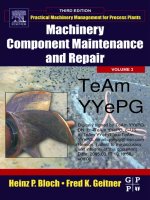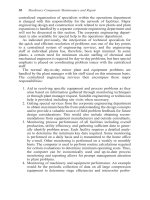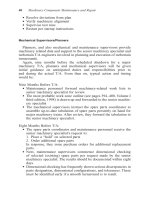Machinery Component Maintenance and Repair P1
Bạn đang xem bản rút gọn của tài liệu. Xem và tải ngay bản đầy đủ của tài liệu tại đây (2.18 MB, 40 trang )
TeAm
YYePG
Digitally signed by TeAm YYePG
DN: cn=TeAm YYePG, c=US,
o=TeAm YYePG, ou=TeAm
YYePG, email=
Reason: I attest to the accuracy
and integrity of this document
Date: 2005.03.17 10:10:58
+08'00'
Practical Machinery Management for Process Plants
Volume 3, Third Edition
Machinery Component
Maintenance and Repair
This page intentionally left blank
Practical Machinery Management for Process Plants
Volume 3, Third Edition
Machinery Component
Maintenance and Repair
AMSTERDAM
•
BOSTON
•
HEIDELBERG
•
LONDON
•
NEW YORK
OXFORD
•
PARIS
•
SAN DIEGO
•
SAN FRANCISCO
•
SINGAPORE
SYDNEY
•
TOKYO
Gulf Professional Publishing is an imprint of Elsevier
Heinz P. Bloch and
Fred K. Geitner
Gulf Professional Publishing is an imprint of Elsevier
30 Corporate Drive, Suite 400, Burlington, MA 01803, USA
Linacre House, Jordan Hill, Oxford OX2 8DP, UK
Copyright © 2005, Elsevier Inc. All rights reserved.
No part of this publication may be reproduced, stored in a retrieval system, or transmitted in any
form or by any means, electronic, mechanical, photocopying, recording, or otherwise, without the
prior written permission of the publisher.
Permissions may be sought directly from Elsevier’s Science & Technology Rights
Department in Oxford, UK: phone: (+44) 1865 843830, fax: (+44) 1865 853333, e-mail:
You may also complete your request on-line via the Elsevier
homepage (), by selecting “Customer Support” and then “Obtaining
Permissions.”
Recognizing the importance of preserving what has been written, Elsevier prints its books on acid-
free paper whenever possible.
Library of Congress Cataloging-in-Publication Data
Application submitted
British Library Cataloguing-in-Publication Data
A catalogue record for this book is available from the British Library.
ISBN: 0-7506-7726-0
For information on all Gulf Professional Publishing publications visit our Web site at
www.books.elsevier.com
04050607080910987654321
Printed in the United States of America
v
Contents
Foreword . . . . . . . . . . . . . . . . . . . . . . . . . . . . . . . . . . . . . . . . viii
Acknowledgments. . . . . . . . . . . . . . . . . . . . . . . . . . . . . . . . . . . ix
Part I: Background to Process Machinery Maintenance
Programming . . . . . . . . . . . . . . . . . . . . . . . . . . . . . . . . . . . 1
1 Machinery Maintenance: An Overview . . . . . . . . . . . . . . . . . 3
2 Maintenance Organization and Control for Multi-Plant
Corporations . . . . . . . . . . . . . . . . . . . . . . . . . . . . . . . . . . . 11
Type of Operation. Manager’s Role. Maintenance. Central Control System.
Incentives for Computer Systems. Setting Up an Effective System. Machinery
Maintenance on the Plant Level. Assignment of Qualified Personnel. Timing and
Basic Definition of Critical Pre-Turnaround Tasks. Specific Preparation and
Planning. Documenting What You’ve Done.
3 Machinery Foundations and Grouting . . . . . . . . . . . . . . . . . . 61
What’s an Epoxy? Epoxy Grouts. Proper Grout Mixing Is Important. Job
Planning. Conventional Grouting. Methods of Installing Machinery. Pressure-
Injection Regrouting. Prefilled Equipment Baseplates: How to Get a Superior
Equipment Installation for Less Money. Appendix 3-A—Detailed Checklist for
Rotating Equipment: Horizontal Pump Baseplate Checklist. Appendix 3-B—
Specification for Portland Cement Grouting of Rotating Equipment. Appendix
3-C—Detailed Checklist for Rotating Equipment: Baseplate Grouting. Appen-
dix 3-D—Specifications for Epoxy Grouting of Rotating Equipment. Appendix
3-E—Specification and Installation of Pregrouted Pump Baseplates.
v
4 Process Machinery Piping . . . . . . . . . . . . . . . . . . . . . . . . . . 148
Fundamentals of Piping Design Criteria. Piping Design Procedure. The When,
Who, What, and How of Removing Spring Hanger Stops Associated with
Machinery. Flange Jointing Practices. Primary Causes of Flange Leakage. The
Importance of Proper Gasket Selection. Flange Types and Flange Bolt-Up.
Controlled Torque Bolt-Up of Flanged Connections. Recommendations for the
Installation, Fabrication, Testing, and Cleaning of Air, Gas, or Steam Piping.
Pickling Procedure for Reciprocating Compressor Suction Piping: Method I.
Cleaning of Large Compressor Piping: Method II. Appendix 4-A—Detailed
Checklist for Rotating Equipment: Machinery Piping. Appendix 4-B—Specifi-
cations for Cleaning Mechanical Seal Pots and Piping for Centrifugal Pumps.
Appendix 4-C—Detailed Checklist for Rotating Equipment: Pump Piping.
Part II: Alignment and Balancing . . . . . . . . . . . . . . . . . . . . . . . . . 197
5 Machinery Alignment. . . . . . . . . . . . . . . . . . . . . . . . . . . . . . 199
Prealignment Requirements. Choosing an Alignment Measurement Setup.
Checking for Bracket Sag. Face Sag Effect—Examples. Interpretation and Data
Recording. The Graphical Procedure for Reverse Alignment. Thermal Growth—
Twelve Ways to Correct for It. Thermal Growth Estimation by Rules of Thumb.
6 Balancing of Machinery Components . . . . . . . . . . . . . . . . . . . 258
Definition of Terms. Purpose of Balancing. Types of Unbalance. Motions of
Unbalanced Rotors. Balancing Machines. Centrifugal Balancing Machines.
Measurement of Amount and Angle of Unbalance. Classification of Centrifugal
Balancing Machines. Maintenance and Production Balancing Machines. Estab-
lishing a Purchase Specification. Supporting the Rotor in the Balancing
Machine. End-Drive Adapters. Balancing Keyed End-Drive Adapters. Balanc-
ing Arbors. Testing Balancing Machines. Inboard Proving Rotors for Horizontal
Machines. Test Procedures. Balance Tolerances. Special Conditions to Achieve
Quality Grades G1 and G0.4. Balance Errors Due to Rotor Support Elements.
Recommended Margins Between Balance and Inspection Tolerances. Computer-
Aided Balancing. Field Balancing Overview. Field Balancing Examples.
Appendix 6-A—Balancing Terminology. Appendix 6-B—Balancing Machine
Nomenclature. Appendix 6-C—Balancing and Vibration Standards. Appendix 6-
D—Critical Speeds of Solid and Hollow Shafts.
Part III: Maintenance and Repair of Machinery Components . . . . . 367
7 Ball Bearing Maintenance and Replacement . . . . . . . . . . . . . . 369
Engineering and Interchangeability Data. Cleanliness and Working Conditions
in Assembly Area. Removal of Shaft and Bearings from Housing. Cleaning the
vi
Bearing. Shaft and Housing Preparation. Checking Shaft and Housing
Measurements. Basic Mounting Methods. Hints on Mounting Duplex Bearings.
Preloading of Duplex Bearings. Importance of the Correct Amount of Preload.
Assembly of Bearings on Shaft. Cautions to Observe During Assembly of
Bearings into Units. Mounting with Heat. Checking Bearings and Shaft After
Installation. Assembly of Shaft and Bearings into Housing. Testing of Finished
Spindle. Maintain Service Records on All Spindles.
8 Repair and Maintenance of Rotating Equipment
Components . . . . . . . . . . . . . . . . . . . . . . . . . . . . . . . . . . . . 447
Pump Repair and Maintenance. Installation of Stuffing Box Packing. Welded
Repairs to Pump Shafts and Other Rotating Equipment Components. How to
Decide if Welded Repairs Are Feasible. Case Histories. High Speed Shaft Repair.
Shaft Straightening. Straightening Carbon Steel Shafts. Casting Salvaging
Methods. OEM vs. Non-OEM Machinery Repairs.
9 Centrifugal Compressor Rotor Repair . . . . . . . . . . . . . . . . . . 501
Compressor Rotor Repairs. Impeller Manufacture. Compressor Impeller Design
Problems. Impeller Balancing Procedure. Rotor Bows in Compressors and
Steam Turbines. Clean-Up and Inspection of Rotor. Disassembly of Rotor for
Shaft Repair. Shaft Design. Rotor Assembly. Shaft Balancing. Rotor Thrust in
Centrifugal Compressors. Managing Rotor Repairs at Outside Shops. Mounting
of Hydraulically Fitted Hubs. Dismounting of Hydraulically Fitted Hubs.
10 Protecting Machinery Parts Against Loss of Surface . . . . . . . 536
Basic Wear Mechanisms. Hard-Surfacing Techniques. Special Purpose Mate-
rials. The Detonation Gun Process. Selection and Application of O-Rings.
Appendix 10-A—Part Documentation Record. Procedures and Materials Used
for Hard-Surfacing.
Index . . . . . . . . . . . . . . . . . . . . . . . . . . . . . . . . . . . . . . . . . . . . 617
vii
Foreword
A machinery engineer’s job was accurately described by this ad, which ap-
peared in the classified section of the New York Times on January 2, 1972:
Personable, well-educated, literate individual with college degree
in any form of engineering or physics to work...Job requires wide
knowledge and experience in physical sciences, materials, con-
struction techniques, mathematics and drafting. Competence in the
use of spoken and written English is required. Must be willing to
suffer personal indignities from clients, professional derision from
peers in more conventional jobs, and slanderous insults from
colleagues.
Job involves frequent physical danger, trips to inaccessible loca-
tions throughout the world, manual labor and extreme frustration
from lack of data on which to base decisions.
Applicant must be willing to risk personal and professional
future on decisions based on inadequate information and complete
lack of control over acceptance of recommendations...
The situation has not changed. As this third edition goes to press, there is an
even greater need to seek guidelines, procedures, and techniques that have worked
for our colleagues elsewhere. Collecting these guidelines for every machinery
category, size, type, or model would be almost impossible, and the resulting ency-
clopedia would be voluminous and outrageously expensive. Therefore, the only
reasonable course of action has been to be selective and assemble the most impor-
tant, most frequently misapplied or perhaps even some of the most cost-effective
maintenance, repair, installation, and field verification procedures needed by
machinery engineers serving the refining and petrochemical process industries.
This is what my colleagues, Heinz P. Bloch and Fred K. Geitner, have suc-
ceeded in doing. Volume 3 of this series on machinery management brings us the
know-how of some of the most knowledgeable individuals in the field. Engineers
and supervisors concerned with machinery and component selection, installation,
and maintenance will find this an indispensable guide.
Here, then, is an updated source of practical reference information which the
reader can readily adapt to similar machinery or installations in his particular
plant environment.
Uri Sela
Walnut Creek, California
viii
Acknowledgments
It would have been quite impossible to write this text without the help and
cooperation of many individuals and companies. These contributors have earned
our respect and gratitude for allowing us to use, adapt, paraphrase, or otherwise
incorporate their work in Volume 3: W. J. Scharle (Multi-Plant Maintenance),
J. D. Houghton (Planning Turbomachinery Overhauls), E. M. Renfro/Adhesive
Services Company (Major Machinery Grouting and Foundation Repair), M. G.
Murray (Grouting Checklists, Machinery Alignment), Prueftechnik A. G. (Laser
Alignment), P. C. and Todd Monroe (Machinery Installation Checklists and Pre-
Grouted Baseplates), J. W. Dufour (Machinery Installation Guidelines), W.
Schmidt (Piping Connection Guidelines), Garlock Sealing Technologies and Flex-
itallic, Inc. (Gasket Selection and Flange Torque Requirements), D. C. Stadel-
bauer, Schenk Trebel Corporation (Balancing of Machinery Components), MRC
Division of SKF Industries (Bearing Installation and Maintenance), Flowserve
Corporation (Metallic Seal Installation, Repair, Maintenance), H. A. Scheller
(Pump Packing), T. Doody (Welded Repairs to Pump Shafts, etc.), H. A. Erb
(Repair Techniques for Machinery Rotor and Case Damage), Byron Jackson,
Division of Flowserve Corporation (Field Machining Procedures), Terry Wash-
ington, In-Place Machining Company (Metal Stitching Techniques), Tony Casillo
(OEM vs. NON-OEM Machinery Repairs), Barney McLaughlin, Hickham Indus-
tries, Inc., and W. E. Nelson (Compressor Rotor and Component Repairs, Sealing
Compounds, etc.), M. Calistrat/Koppers Company (Mounting Hydraulically
Fitted Hubs), Larry Ross, C. R. McKinsey and K. G. Budinski (Hard Surfacing),
C. R. Cooper, Van Der Horst Corporation (Chrome Plating), Turbine Metal Tech-
nology (Diffusion Alloys) and National O-Ring Company (O-Ring Selection and
Application).
We also appreciate our close personal friend Uri Sela who devoted so much of
his personal time to a detailed review of the entire draft, galleys, and page proofs.
Uri counseled us on technical relevance, spelling, syntax, and other concerns.
More than ever before, we are reminded of some important remarks made by
Exxon Chemical Technology Vice President W. J. Porter, Jr. in early 1984. Mr.
Porter expressed the belief that through judicious use of outside contacts, partic-
ipation in relevant activities of technical societies, and publication of pertinent
material, we can be sure that our technical productivity will continue to improve.
The technical person will thus be updated on the availability of “state-of-the-art”
tools and individual creativity encouraged.
We hope this revised text will allow readers to find new and better ways to do
their jobs, broaden their perspective as engineers, and contribute to a fund of
knowledge which—if properly tapped—will bring benefits to everyone.
Heinz P. Bloch
Fred K. Geitner
ix
This page intentionally left blank
Part I
Background to
Process Machinery
Maintenance
Programming
This page intentionally left blank
Chapter 1
Machinery Maintenance:
An Overview
Maintenance and repair of machinery in a petrochemical process plant
was defined in a preceding volume as simply “defending machinery
equipment against deterioration.”
1
Four strategies within the failure-
fighting role of maintenance were defined:
•
Preventive
•
Predictive
•
Breakdown or demand based
•
“Bad actor” or weak spot management
Machinery maintenance can often be quite costly in a petrochemical
plant operation. Prior to the publication of the first two volumes of this
series, very few studies were available describing quantitative or objective
methods for arriving at the optimization of the four strategies
2
. Though
our readers should not expect detailed contributions to those subjects in
this volume, we did opt to include an overview section describing the
maintenance philosophy practiced in a large multi-plant corporation which
makes effective use of centralized staff and computerized planning and
tracking methods.
What, then, can our readers expect? After a short definition of the
machinery maintenance problem we will highlight centralized main-
tenance planning. We will then guide our readers through the world of
machinery maintenance procedures by identifying the What, When,
Where, Why, How—and sometimes Who—of most maintenance and
repair activities around petrochemical process machinery. We ask,
however, that our readers never lose sight of the total picture. What, then,
is the total picture?
3
It is the awareness that true cost savings and profitability can only be
achieved by combining machinery reliability, safety, availability, and
maintainability into a cost-effective total—consistent with the intent of
our series of volumes on process machinery management. Figure 1-1
illustrates this concept. Consequently, machinery maintenance cannot be
looked at in isolation. It will have to be governed by equipment failure
experience, by our effectiveness in failure analysis and troubleshooting
1
,
and by built-in reliability
3
.
Maintenance in a broad definition is concerned with controlling the
condition of equipment. Figure 1-2 is a classification of most machinery
maintenance problems.
Deterministic or predictive component life problems are those where
no uncertainty is associated with the timing or consequence of the main-
tenance action. For example, we may have equipment whose components
are not subject to actual failure but whose operating cost increases with
time. A good illustration would be labyrinths in a centrifugal process com-
pressor. To reduce operating cost caused by increasing leakage rate, some
form of maintenance work can be done—usually in the form of replace-
ment or overhaul. After maintenance the future trend in operating cost is
known or at least anticipated. Such a deterministic situation is illustrated
in Figure 1-3.
4 Machinery Component Maintenance and Repair
Figure 1-1. The total picture: Possible goals of process machinery management.
Machinery Maintenance: An Overview5
Figure 1-2.
Classification of machinery maintenance problems.









